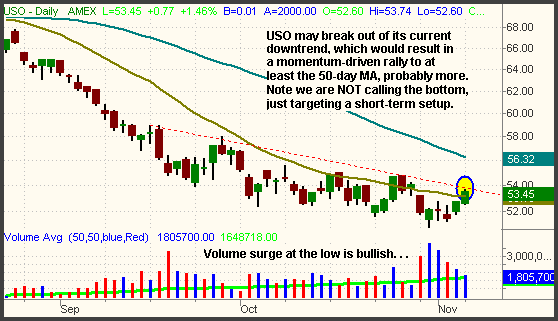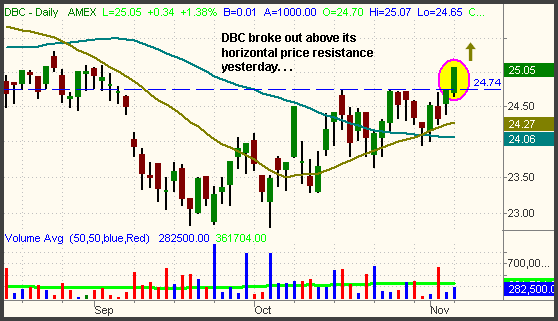As anticipated, the S&P 500, Dow Jones Industrial Average, and Nasdaq Composite each bounced off support of their primary uptrend lines yesterday, enabling the major indices to recover last week's losses. The Nasdaq Composite rallied 1.5%, the S&P 500 gained 1.1%, and the Dow Jones Industrial Average advanced 1.0%. Small and mid-cap stocks kept pace with the other indices, but did not outperform as we often see on many rally days. The Russell 2000 gained 1.4% and the S&P Mid-cap 400 closed 1.1% higher. A minor wave of selling in the final fifteen minutes of trading caused the broad market to close off its high, but the major indices still finished in the upper 20% of their intraday ranges. Unfortunately, however, overall volume was only marginally higher.
Despite yesterday's firm gains, the low turnover was disappointing for the bulls. In both the NYSE and Nasdaq, total volume increased by only 1% over the previous day's levels. Volume in the NYSE was so light that it failed to exceed its 50-day average level. The Nasdaq volume barely came in above its 50-day average. After snapping back sharply from last week's losses, one would have expected to see more shares changing hands, but institutions were not interested in aggressively buying stocks. Since volume was unimpressive on the upside, keep a close eye on the price to volume relationship in the broad market throughout the remainder of the week. A sole session of higher volume losses could easily trigger another correction that would wipe out yesterday's gains in short order.
On the first day following a multi-day correction that the stock market rallies significantly, it's a good idea to take a look at which industry sectors showed the most relative strength and weakness. If the top gainers were sectors that also declined the least when the broad market corrected, that means leadership came from the sectors with relative strength. However, sometimes the top gaining sectors on the first bounce following a selloff will merely be the sectors that got hammered and are merely putting in a technical bounce. Distinguishing between the two scenarios is important because you want to only be long the sectors with the most relative strength to the broad market, not those that recaptured several percent of a large loss the previous week. Therefore, let's analyze yesterday's industry sector action in order to get a better idea of where the money was flowing.
Of the major industries we follow, the top gainers yesterday were: Securities Broker-Dealer Index ($XBD), Computer Networking ($NWX), Transportation ($DJT), Semiconductors ($SOX), and Oil Service ($OSX). Of these, Transportation is the one sector we would avoid buying because it showed a lot of relative weakness during last week's selloff. Semiconductors and Computer Networking have been choppy and indecisive in both directions, so neither are good candidates for further upside at this point. The Securities Brokers, however, have been holding up well in recent weeks, and yesterday's 2.6% gain confirmed its relative strength.
The Oil Service Index, which we have discussed extensively over the past week, has been mounting a stealth rally ever since breaking out above its five-month downtrend line two weeks ago. After adjusting our break-even stop back down a bit to allow for a bit of "wiggle room" on October 30, the Oil Service HOLDR (OIH) hit that stop on November 2. But it displayed very tricky price action indeed, as it reversed sharply off support of its 50-day moving average and rallied to a new intraday high later that afternoon. We viewed the action as the final shakeout attempt before resuming higher, so we sent a real-time intraday e-mail alert to subscribers, informing them we were re-entering the OIH position. We bought back in to OIH more than 1.5 points above where we stopped out, but we're glad we did. As of yesterday's close, OIH is showing a gain of nearly 6 points since our re-entry. As long as the setup is still valid, positions we re-enter often turn out to be our most profitable trades. Clearly, one has to overcome the human psychological reluctance to promptly jump back in a position at a higher price than where it just stopped out.
The Oil Service Index has been showing a lot more relative strength than the price of the crude oil commodity, but it seems that crude is now trying to break out of its downtrend as well. If it does, it will present a short-term trading opportunity for swing traders. The best ETF vehicle to directly capitalize on a rally in crude oil is the U.S. Oil Fund (USO), which roughly mirrors the price of the crude oil commodity. Much to the delight of automobile owners, USO (as a representation of crude oil) has been in a steady downtrend since peaking on July 14. However, it seems to finally be putting in at least a short-term bottom. Looking at the daily chart, notice how USO closed above its 20-day moving average and is poised to break out above its downtrend line from the September 18 high:

If USO rallies above yesterday's high, it will have broken out above its 7-week downtrend line. Such a move should generate further upside momentum that carries USO at least up to its 50-day moving average, and most likely a few points beyond that, up to resistance of the September 18 high. But first, USO must move firmly above yesterday's high. With this setup, be sure to understand that we are not calling a bottom in USO because there is not yet enough price confirmation to do so. Rather, we are merely anticipating a tradeable bounce from "oversold" conditions in the price of crude oil and USO.
Our long entry in the DB Commodity Trust (DBC) triggered yesterday, which will also be aided by further strength in crude oil:

As for the other open positions, the StreetTRACKS Gold Trust (GLD) backed off a bit yesterday and has begun to consolidate its recent gains. We already sold half of our position into strength last Friday, but intend to hold the remaining shares through its first normal correction that has begun. The Semiconductor HOLDR (SMH) rallied against us yesterday, but is still showing a small unrealized gain. We lowered the stop to reduce our risk yesterday, as the sector has primarily been choppy.
The S&P, Dow, and Nasdaq did what they were "supposed to do" by rallying off support of their primary uptrend lines yesterday. However, they still must contend with the overhead supply from resistance of their October 26 highs. Unless they clear those levels, caution is still advised on the long side of the market, especially with volume being so light yesterday. The resistance levels are as follows: S&P 500 - 1,389.45, Dow Jones - 12,167.02, and Nasdaq Composite - 1,379.29. As always, remember to trade what you see, not what you think!
Deron Wagner is the Founder and Head Trader of both Morpheus Capital LP, a U.S. hedge fund, and Morpheus Trading Group, a trader education firm launched in 2001 that provides daily technical analysis of the leading ETFs and stocks. For a free trial to the full version of The Wagner Daily or to learn about Wagner's other services, visit MorpheusTrading.com or send an e-mail to deron@morpheustrading.com.